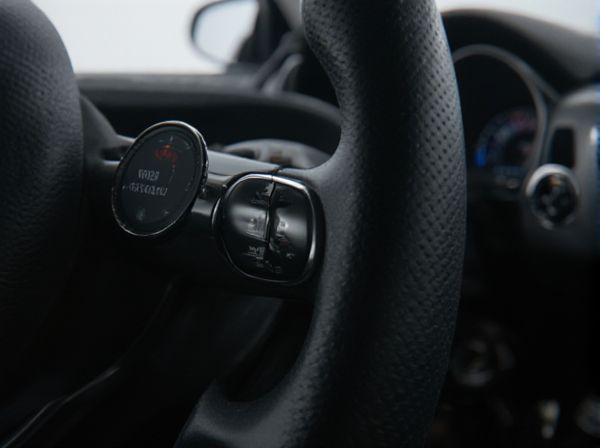
Photo illustration: Throttle Steering vs Lift-off Steering
Throttle steering uses controlled acceleration and engine torque to assist in cornering by transferring weight and improving traction, enhancing vehicle stability during turns. Lift-off steering involves easing off the throttle to shift weight forward, increasing front tire grip for sharper steering response in critical situations. You can maximize driving control by understanding when to apply throttle steering for smooth handling or lift-off steering for precision maneuvering.
Table of Comparison
| Feature | Throttle Steering | Lift-off Steering |
|---|---|---|
| Definition | Steering control achieved by modulating the throttle. | Steering control via reducing throttle input (lifting off the accelerator). |
| Primary Mechanism | Throttle input increases torque to assist turn. | Throttle release induces weight transfer and understeer/oversteer effects. |
| Effect on Vehicle Dynamics | Enhances rear-wheel slip, aiding sharper turns and drift. | Shifts weight forward, increasing front grip and stabilizing corner. |
| Use Case | Common in performance driving and drifting. | Used in smooth corner adjustments and safer steering corrections. |
| Driver Skill Level | Requires advanced throttle modulation expertise. | Suitable for intermediate drivers focusing on smooth control. |
| Impact on Tire Wear | Increases rear tire wear due to slip. | Minimizes tire wear from smoother handling. |
| Risk Factor | Higher risk of oversteer and loss of control if misapplied. | Lower risk; promotes vehicle stability. |
Introduction to Throttle and Lift-off Steering
Throttle steering involves modulating the gas pedal to control a vehicle's turning radius and stability, primarily by increasing or decreasing engine power during cornering. Lift-off steering is the technique of easing off the throttle to induce weight transfer that enhances traction and initiates controlled oversteer or understeer. Both methods are critical in performance driving and rally racing, where precise throttle input directly influences vehicle dynamics and handling response.
What is Throttle Steering?
Throttle steering is a technique primarily used in rear-wheel-drive vehicles where drivers control the throttle to induce oversteer, allowing the rear wheels to slide and steer the car through corners. By modulating the accelerator, throttle steering adjusts the vehicle's yaw angle, enhancing cornering agility without relying solely on the steering wheel input. This method is widely employed in motorsports and drifting to maintain speed and control during tight turns.
What is Lift-off Steering?
Lift-off steering is a driving technique where the driver gently releases the throttle mid-corner to induce slight oversteer, aiding in vehicle rotation and improving cornering control. This method allows the rear tires to lose some grip without fully sliding, enhancing agility and stability during turns. Lift-off steering is commonly used in rally and performance driving to maintain momentum and adjust vehicle trajectory effectively.
Key Differences: Throttle vs Lift-off Steering
Throttle steering uses increased engine power to induce oversteer by breaking rear wheel traction, enabling quicker and more aggressive cornering. Lift-off steering relies on sudden throttle reduction to shift weight forward, causing the rear wheels to lose grip and initiate a controlled slide. The key difference lies in throttle application: throttle steering applies positive throttle input for rear wheel slip, while lift-off steering uses throttle release to transfer weight and trigger oversteer.
When to Use Throttle Steering
Throttle steering offers precise control in low-speed, technical riding scenarios where tight turns and wheel traction management are critical, such as in trials or off-road maneuvers. This technique is ideal when negotiating obstacles or maintaining balance on uneven terrain, allowing riders to modulate power and lean without abrupt changes in handlebar input. Use throttle steering to enhance stability and responsiveness during slow, controlled movements where fine throttle adjustments directly influence the bike's direction.
When to Use Lift-off Steering
Lift-off steering is most effective during high-speed cornering or when traction control is limited, allowing drivers to reduce understeer by gently releasing the throttle to transfer weight to the front wheels, enhancing grip. It is especially useful on slippery surfaces or in rally driving where precise vehicle control is critical. Understanding throttle modulation in lift-off steering helps maintain stability and improves cornering performance without abrupt steering inputs.
Advantages of Throttle Steering
Throttle steering offers precise control by modulating engine power to influence vehicle direction, enhancing maneuverability at low speeds or in tight spaces. This method reduces wear on the steering system compared to lift-off steering, which relies on deceleration to correct the path, often causing abrupt handling changes. Optimized throttle input maintains stability and traction, particularly on slippery surfaces, improving overall driving performance.
Benefits of Lift-off Steering
Lift-off steering enhances vehicle control by reducing understeer during cornering, allowing drivers to navigate turns more precisely without abrupt throttle adjustments. This technique improves traction and stability by shifting weight forward, increasing front tire grip essential for safe and efficient corner entry. Lift-off steering also promotes smoother driving dynamics and reduces the risk of oversteer compared to throttle steering, making it preferable for maintaining balance in high-performance and everyday driving scenarios.
Safety Considerations for Each Technique
Throttle steering enhances vehicle control by modulating engine power to maintain traction during cornering, reducing the risk of understeer and improving stability on loose or slippery surfaces. Lift-off steering employs deceleration to induce weight transfer, increasing front-wheel grip for sharper turns but requires precise timing to avoid sudden oversteer or loss of control. Each technique demands driver skill to balance throttle input and steering angle, with throttle steering generally offering safer, more gradual adjustments, while lift-off steering poses higher risks if misapplied, especially at high speeds.
Choosing the Best Steering Technique for Your Driving Style
Throttle steering provides precise control by modulating engine power, ideal for aggressive drivers seeking dynamic cornering and improved oversteer handling. Lift-off steering offers a smoother approach by reducing throttle input to induce gentle rear-end rotation, suited for those preferring a more controlled, less aggressive driving style. Selecting the best technique depends on factors like vehicle setup, road conditions, and personal driving preferences to maximize performance and safety.
 caratoz.com
caratoz.com